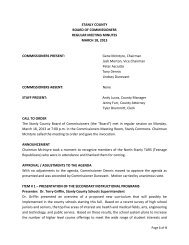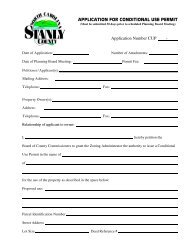Land Use Plan – 2002 - Stanly County, North Carolina
Land Use Plan – 2002 - Stanly County, North Carolina
Land Use Plan – 2002 - Stanly County, North Carolina
Create successful ePaper yourself
Turn your PDF publications into a flip-book with our unique Google optimized e-Paper software.
STANLY COUNTY<br />
Secondary growth areas are also identified for the eight towns and crossroad settlements<br />
discussed above in the primary growth area section.<br />
As with the portions of the primary growth areas, a percentage of the secondary growth area lies<br />
within the ETJs of a number of cities. This situation is most dramatically displayed in New<br />
London and Oakboro.<br />
Conservation Area<br />
The conservation area includes the majority of the study area. The chief purpose of the<br />
conservation area is to protect farmland from rural sprawl today, and from urban sprawl in the<br />
future. The conservation area is also intended to protect woodland areas as well as open space<br />
in this portion of the study area. As it is expected that development pressure will extended into<br />
<strong>Stanly</strong> <strong>County</strong> from Cabarrus, Mecklenburg, and Union Counties, it is anticipated that urban<br />
sprawl will begin to be experienced in the vicinity of Finger, Millingport, and Ridgecrest at the<br />
end of the 20-year planning period.<br />
Low-density residential development will be permitted in the conservation area. The present<br />
permitted development density of the R-A, Residential-Agricultural Zoning District, a zoning<br />
district that encompasses the majority of the study area, allows single-family residential<br />
development at the rate of one dwelling unit per acre.<br />
A development density of one dwelling unit per acre is encouraged for this area. To allow for<br />
flexibility in applying this density recommendation, the one-acre development density shall be<br />
expressed as an average development density over a single property. In this way, lot sizes will<br />
not be required to be a minimum of one acre in size. For example, from an existing 20-acre<br />
“parent” lot, a total of 20 lots of varying size may be created. These lots may be less than one<br />
acre in size, or at least the minimum necessary to allow for the safe operation of a well, septic<br />
system, and back-up septic system on the lot as determined by standards established by the<br />
<strong>Stanly</strong> <strong>County</strong> Environmental Health Department.<br />
This will allow farmers to continue to operate their farm and sell portions of their property to their<br />
children or for income.<br />
In addition to this flexible one-acre zoning requirement, it is encouraged that farm protection and<br />
preservation programs be encouraged to sustain the rural way of life in <strong>Stanly</strong> <strong>County</strong>. Examples<br />
programs include purchase of development rights, transfer of development rights, and<br />
conservation easements. Conservation development may be an appropriate model for<br />
application in the agricultural conservation area when land is located in close proximity to a the<br />
secondary growth area, such as near a unincorporated town or crossroad settlement.<br />
Explanations of each of these implementation strategies and tools is provided later in this report.<br />
Figure 6-3 provides an illustration of the manner in which the flexible development density<br />
system proposed in the conservation area.<br />
Special Protection Areas<br />
The final generalized land use category illustrated in Figure 6-1 is a series of special protection<br />
areas intended to protect unique assets found in <strong>Stanly</strong> <strong>County</strong>. Three such areas are identified<br />
on the <strong>Land</strong> <strong>Use</strong> <strong>Plan</strong> map:<br />
Albemarle-<strong>Stanly</strong> <strong>County</strong> Airport Protection Area—<strong>Land</strong> in the vicinity of Albemarle-<br />
<strong>Stanly</strong> <strong>County</strong> Airport is rapidly developing, particularly on the southwest side of the airport<br />
near Albemarle. Only a small portion of the secondary growth areas for Badin encroaches<br />
onto airport land. It is recommended that land associated with the airport approaches be<br />
protected to preserve the long-range sustainability of the airport. In addition to serving the<br />
<strong>Land</strong> <strong>Use</strong> <strong>Plan</strong> 6-13 6/02






